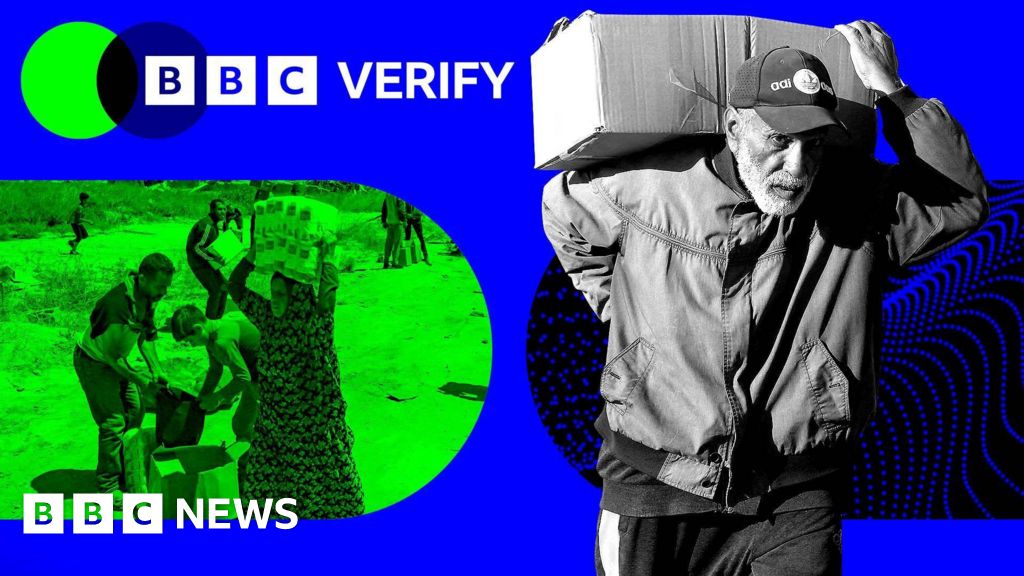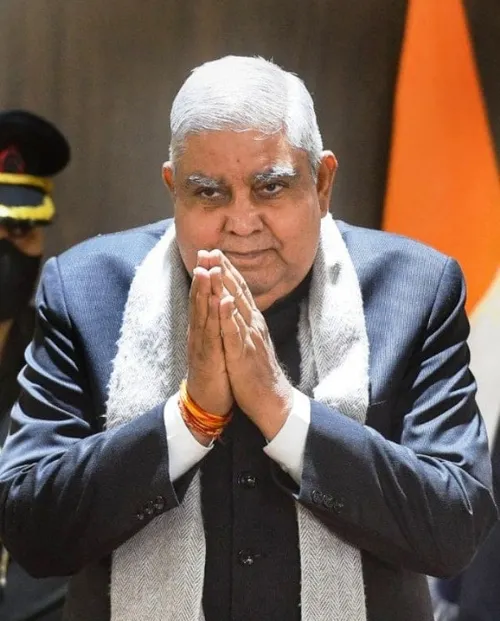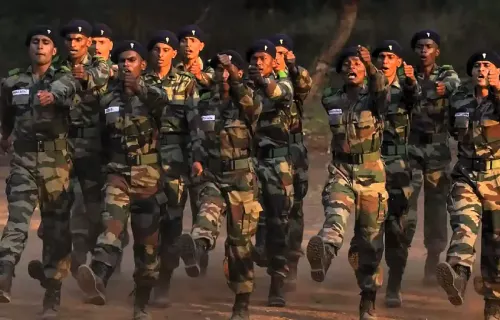BBC Verify
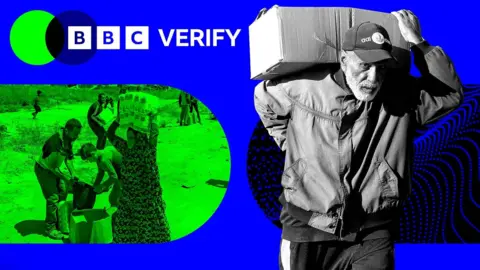 BBC
BBCThe masked and armed security contractor atop a dirt mound watches thousands of Palestinians who have been kettled into narrow lanes separated by fences below.
He makes a heart shape with his hands and the crowd responds – the fence begins to bend as they push against it.
This jubilant scene was filmed on Tuesday, the opening day of an aid distribution centre – a vital lifeline for Gazans who haven’t seen fresh supplies come into the strip for more than two months due to an Israeli blockade.
But by that afternoon, the scene was one of total chaos. Videos showed the distribution centre overrun by desperate civilians trampling over toppled barriers; people flinched as sounds of gunshots rang out.
This was the disorderly start to a controversial new aid distribution scheme operated by the Gaza Humanitarian Foundation (GHF), a newly created body backed the the US and Israel.
GHF has been tasked with feeding desperately hungry Gazans. The UN said more than two million are at risk of starvation.
 Telegram
TelegramThe foundation, which uses armed American security contractors, aims to bypass the UN as the main supplier of aid in Gaza. It has been roundly condemned and boycotted by aid agencies and the UN. But Israel has said an alternative to the existing aid system was needed to stop Hamas stealing aid, which the group denies doing.
To get a picture of the first few days of this new aid delivery system, BBC Verify has authenticated dozen of images at distribution sites, interviewed humanitarian and logistics experts, analysed Israeli aid transport data and official statements released by the GHF, and spoken with Gazans searching for supplies.
Chaotic scenes at distribution centres
GHF said it aimed to feed one million Gazans in its first week of operations through four secure distribution sites.
A foundation spokesperson said on Friday, its fourth day of operations, that it had distributed two million meals. The BBC has not been able to verify this figure, which would be less than one meal per Gazan over the course of four days.
GHF did not respond to our inquiries about how it was tracking who had been receiving them.
In a video filmed at GHF’s northern site near Nuseirat on Thursday, Palestinians can be seen being running away from a perimeter fence after GHF contractors threw a projectile that exploded with a loud bang, a flash and smoke.
GHF in a statement said its personnel “encountered a tense and potentially dangerous crowd that refused to disperse”.
“To prevent escalation and ensure the safety of civilians and staff, non-lethal deterrents were deployed—including smoke and warning shots into the ground,” it said.
“These measures were effective”, it added, “and no injuries occurred.” BBC Verify cannot independently confirm this.
Later that evening, GHF warned Gazans via Facebook that it would shut down any site where looting occurred.
The GHF is not the only aid organisation facing serious challenges. The night before the GHF warning, a World Food Programme (WFP) warehouse was looted, resulting in several deaths which are still being investigated.
In response to the incident, the WFP said humanitarian challenges “have spiralled out of control” and called for “safe, unimpeded humanitarian access” to Gaza immediately.
The WFP did not respond to BBC questions about how it would implement further security measures at its warehouses.
Disorganised GHF communication
Palestinians seeking aid have characterised the GHF-led operation as disorganised, saying a lack of communication has contributed to the chaotic scenes seen this week.
Things have been further muddied by misinformation. BBC Verify has seen at least two Facebook profiles purporting to be official GHF accounts, sharing inaccurate information about the status of the aid distribution centres.
One page with more than 4,000 followers posted inaccurate information, sometimes alongside AI-generated images, that aid had been suspended or that looting at GHF centres had been rampant.
A GHF spokesman confirmed to BBC Verify that both these Facebook accounts were fake. He also said that the foundation had launched an official Facebook channel.
Transparency information online showed the page was first created on Wednesday, the day after distribution operations started.
Aid organisation Oxfam and local Gazan residents have told the BBC that residents are instead relying on word of mouth to circulate information when aid was available.
“All of the people are hungry. Everyone fights to get what they want, how are we supposed to get anything?” said Um Mohammad Abu Hajar, who was unable to secure an aid box on Thursday.
Aid agency concerns
Oxfam criticised the location of the GHF distribution sites, telling BBC Verify that it imposed “military control over aid operations”.
It’s policy adviser, Bushra Khalidi, also questioned how vulnerable people, such as the elderly, would be able to reach these sites, which are located some distance away from some population centres.
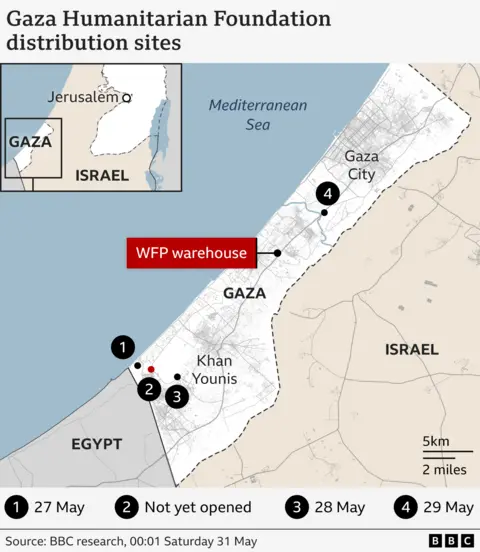
When the UN had been delivering aid before Israel’s humanitarian blockade, there were 400 distribution points spread across Gaza. Under the present GHF distribution system there currently are four known sites.
“By and large, its designed to dramatically increase the concentration of the population by having the only sources of food remaining in a very small number of places,” said Chris Newton, a senior analyst at the brussels-based think tank Crisis Group.
“You either follow all their rules and probably survive in a small radius around these sites or you are very unlikely to survive.”
The presence of armed security and Israeli soldiers at or near the distribution sites has also alarmed experts, who said it undermined faith in aid operations.
“Distributing assistance in this kind of environment is extremely difficult. [It’s] much more effectively done when you are trying to work with, and through, the people there… rather than at the point of a mercenary’s gun,” said Prof Stuart Gordon at the London School of Economics.
A GHF spokesperson said: “Our ability – and willingness – to act under pressure is exactly why GHF remains one of the only organisations still capable of delivering critical food aid to Gaza today.”
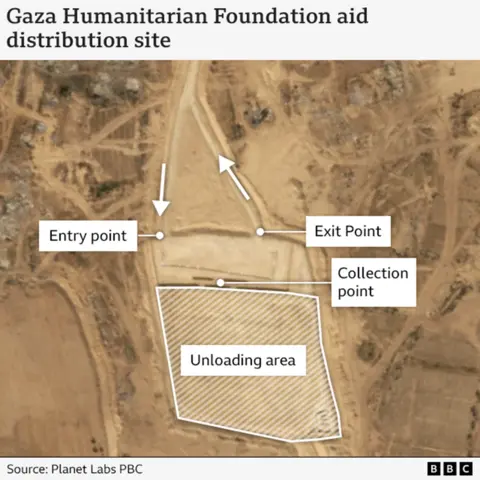
Images and videos taken by eyewitnesses and the Israeli military showed the GHF boxes appeared limited to canned food, pasta, rice, cooking oil and some biscuits and lentils.
“Humanitarian aid is not just a food box that you slap humanitarian on and you call it humanitarian aid,” Ms Khalidi said.
The supplies being given to families should be accompanied by medical support, hygiene and water purification kits, said Prof Gordon.
A 14-page document from GHF, seen by the BBC, promised to hand out water and hygiene kits at the sites.
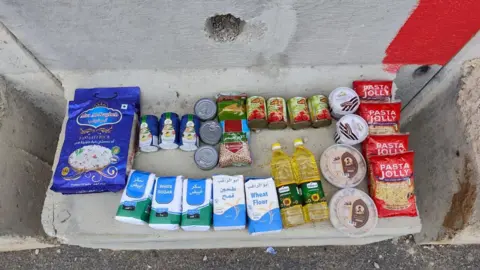 Israeli Defense Forces
Israeli Defense ForcesOn Friday, only one of the four GHF sites was distributing aid. It opened for less than an hour after which GHF announced on Facebook that it had closed because all its supplies had been “fully distributed”.
When asked by BBC Verify why only a single site was operational and why its boxes ran out so quickly, a GHF spokesperson said supply “will vary day by day”.
“Good news is we have provided two million meals in four days and will be ramping up in the coming days and weeks,” the spokesman said.
But many are still returning from distribution sites without boxes for their families.
“I am empty-handed like God created me,” said Hani Abed outside the centre near Netzarim on Thursday.
“I came empty-handed and I left empty-handed.”
Additional reporting and verification by Emma Pengelly, Rudabah Abbass, Alex Murray, Thomas Spencer, Benedict Garman and Richard Irvine-Brown.

Anurag Dhole is a seasoned journalist and content writer with a passion for delivering timely, accurate, and engaging stories. With over 8 years of experience in digital media, she covers a wide range of topics—from breaking news and politics to business insights and cultural trends. Jane's writing style blends clarity with depth, aiming to inform and inspire readers in a fast-paced media landscape. When she’s not chasing stories, she’s likely reading investigative features or exploring local cafés for her next writing spot.
